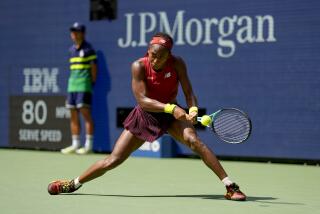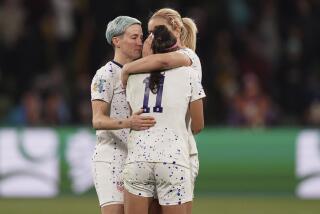Major Trouble Surfaces for U.S. Davis Cup Team
- Share via
MILWAUKEE — There were clues that Jan-Michael Gambill could turn petulant at the slightest bit of adversity and implode in a sea of unforced errors. It had happened against Carlos Moya at the U.S. Open earlier this month.
But veteran Todd Martin was supposed to be the safe, predictable choice. Rarely has he come up so short on such an important occasion, missing the simplest of volleys and losing a tiebreaker without winning a point.
The combination was devastating for the United States on Friday.
Italy took a 2-0 lead in the Davis Cup semifinals against the United States before a sparse crowd at the Milwaukee Arena. The odds are formidable for a comeback, considering the United States has a 1-27 record after trailing, 2-0, in Davis Cup play. The victory was in 1934 against Australia. Italy has lost twice after leading 2-0, most recently two years ago against France.
Gambill, making his Davis Cup debut, lost to Andrea Gaudenzi, 6-2, 0-6, 7-6 (7-0), 7-6 (7-4), in the opening singles match, committing 66 unforced errors. Then Davide Sanguinetti, who played at UCLA, carved up Martin from the baseline, winning, 7-6 (7-0), 6-3, 7-6 (10-8). Martin had 50 unforced errors, including 22 in the opening set.
The United States has won 17 consecutive Davis Cup matches at home. The last time the Americans lost on home soil was in 1987 against West Germany at Hartford, Conn. Of course, Boris Becker was on the other side of the net, not Gaudenzi or Sanguinetti.
Today is the doubles match, and U.S. captain Tom Gullikson said he will not use the experience of Jim Courier, staying with the team of Martin and another Davis Cup rookie, Justin Gimelstob. They are scheduled to play Gaudenzi and Diego Nargiso.
“We just have to go out there and play a good doubles match tomorrow and get one point, get on the board,” Gullikson said. “Then hopefully come back Sunday and have kind of a reversal of today’s fortunes. And maybe win a few tiebreakers.”
Winning one would be a start.
“Obviously, it’s hard to win a tiebreaker when you don’t win a point,” Gullikson said, smiling wryly. “It is very deflating. . . . All of a sudden he [Gambill] got bageled in that [third-set] tiebreaker. It’s like, ‘Wow, where did that come from?’ ”
The Italians used soccer analogies to describe their position, pointing out a 2-0 lead is much different in a three-day Davis Cup competition, as opposed to a World Cup soccer match. Still, even they were surprised at the turn of events--winning six of seven sets and all four tiebreakers.
“Well, we wouldn’t have believed it,” Sanguinetti said.
The weaker lineup--no Pete Sampras, Andre Agassi, Michael Chang or Courier--gave the Italians a boost. Gullikson opted to go with a supposed match-tough Gambill over the experienced Courier because of Courier’s recent arm troubles.
“I don’t like to second-guess myself,” Gullikson said. “You can do that.”
Gambill was clearly unnerved by the occasion--though he had ample support from the announced crowd of 6,071, which appeared closer to 3,500. Gullikson had to continually tell him to stay positive.
“I don’t think I’ve ever been that nervous, but it went away after the first set, so it certainly is not an excuse after the first set,” Gambill said.
Said Gaudenzi, who double-faulted 13 times: “I knew that it is always very, very difficult to play a first match in Davis Cup. I mean, it can play really bad tricks.”
Also open to scrutiny was the choice of the slow indoor surface. The selection was made apparently with Agassi and Courier in mind. But Agassi said long ago that he would be unavailable to play in Milwaukee because of a schedule conflict.
For the Italians, it was almost like clay-court heaven. Sanguinetti played a scintillating match, committing only three unforced errors in the second set.
“We were in Italy and we practiced on a really, really fast surface and we were thinking, ‘Gosh, we hope it is not that fast,’ ” Sanguinetti said. “Because it is not good for the public. It is no fun to play and watch. When we got here, it was so slow. We could have practiced on clay.”
Said Martin: “I was wrong yesterday when I said that conditions might speed up. Jan-Michael and I both had trouble getting the ball to penetrate. We both lost to a couple of counterpunchers, and that shows they executed better than we did. The conditions were a little slower than we would have liked.”
So, what can Gullikson do now?
There’s always that court.
“Maybe speed it up a little bit,” he said, joking. “Put some water on it. Then somehow freeze it. Wisconsin is known for its cold weather.”



